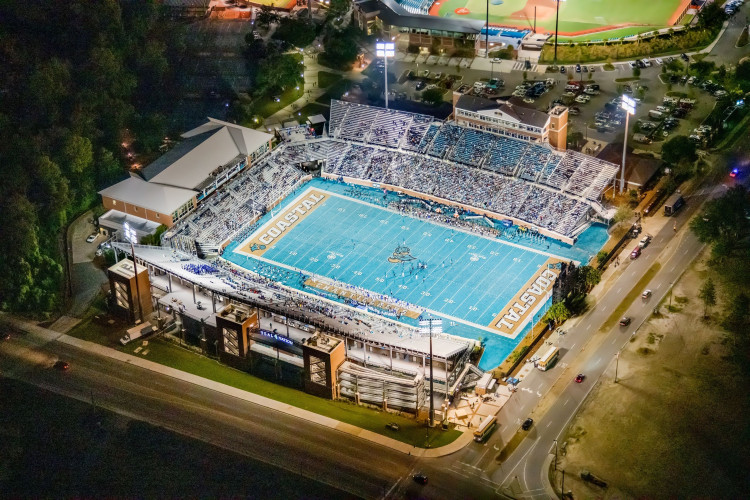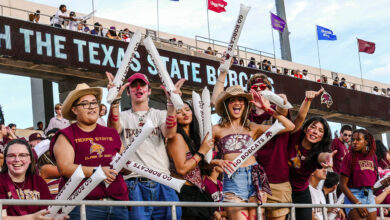Sun Belt Conference Stadiums Ranked Worst to Best

In 2022, the Sun Belt Conference expanded its membership to 14 schools with the inclusion of James Madison University, Marshall University, Old Dominion University, and the University of Southern Mississippi.
As the Sun Belt Conference continues to grow and be recognized as one of the best “Group of Five” conferences in the nation, the football stadiums have become impressive venues to watch college football games.
Which university’s football stadium takes the crown for the best venue in all of the Sun Belt Conference?
In order to put forth an educated answer, the stadiums are ranked upon the following criteria:
The first criterion to consider is the eye test. If a stadium in the Sun Belt Conference doesn’t have the right look, it can impact its overall ranking.
Another important factor is a team’s home record. Do certain stadiums intimidate opponents due to the home team’s success on their turf?
Finally, technological advancements are crucial. Evaluating the stadium’s electronics and any new technological developments that enhance the fan experience will significantly influence the ranking of Sun Belt Conference stadiums.
14. Malone Stadium (UL Monroe)

JPS Field at Malone Stadium, home to UL Monroe, features a distinctive open-ended design that sets it apart from traditional bowl-shaped stadiums. This unique layout provides views of the surrounding campus and natural scenery.
Despite the stadiums unique layout, its design has been noted for resembling that of a local high school team rather than a venue for an FBS-caliber team. Home attendance has been a persistent challenge, with UL Monroe ranking in the bottom half of the Sun Belt in both percent of stadium capacity and average attendance for several years.
Over the past three seasons, UL Monroe has maintained a 9-8 home record.
13. M.M. Roberts Stadium (Southern Mississippi)

The stadium’s nickname, “The Rock,” reflects its solid construction and the spirited atmosphere it fosters during University of Southern Mississippi football games.
M.M. Roberts Stadium faces challenges related to amenities compared to more modern venues. While upgrades have been made to video boards and sound systems, newer stadiums typically offer more advanced technological integrations, larger concourses, premium seating options, and enhanced fan experiences.
Southern Miss has recorded a 7-11 home record over the past three seasons and experienced a 7.39% decrease in overall attendance recently.
12. Centennial Bank Stadium (Arkansas State)

Centennial Bank Stadium, home to the Arkansas State Red Wolves, features a unique stream and fountain in the stands, adding a pleasant touch. Over the last three seasons, Arkansas St has gone 8-10 at home. However, the red wolves saw a 9.71% increase in attendance during the 2022-2023 season.
The stadium has upgraded with robust Wi-Fi and LED lighting systems, enhancing the fan experience.
With a capacity of 30,000, Centennial Bank Stadium provides a family-friendly atmosphere, catering to fans of all ages with comfortable amenities.
11. S.B. Ballard Stadium (Old Dominion)

S.B. Ballard Stadium at Old Dominion University, located in Norfolk, Virginia, benefits from a scenic waterfront location near the Elizabeth River, offering a picturesque backdrop enhancing the game-day atmosphere.
The stadium features contemporary architecture with sleek lines, open concourses, and state-of-the-art facilities. Recent upgrades enhance the fan experience with comfortable seating and ample amenities.
One unique challenge faced by S.B. Ballard Stadium is its proximity to the Elizabeth River. While the waterfront setting provides scenic views, it also presents challenges such as occasional flooding and increased vulnerability to severe weather conditions.
Over the past three seasons, Old Dominion University has maintained a 10-8 record, but has experienced a notable decline in overall fan attendance by 11.78%.
10. Hancock Whitney Stadium (South Alabama)

Hancock Whitney Stadium, home to South Alabama football since 2020, accommodates 25,450 fans in a $78 million state-of-the-art facility. Despite lacking scenic appeal, it features LED Lighting for light shows and a top-ranked high videoboard.
South Alabama holds a 14-5 record at Hancock Whitney Stadium over the last three years. According to attendance trends for the 2022-2023 season, South Alabama has seen an increase of 3.27% in attendance.
The stadium serves as a focal point for community unity, drawing support from local businesses, alumni, and student organizations.
9. Cajun Field (Louisiana)

Cajun Field, located at the University of Louisiana at Lafayette, presents a traditional stadium appearance that may not exude the intimidation of larger or more modern venues.
However, it embodies elements of Louisiana’s vibrant cultural heritage, showcasing local cuisine, music, and traditions that enhance the fan experience on game days.
During the 2022-2023 season, overall fan attendance at Cajun Field increased by 11.11%, reflecting growing support for the Ragin’ Cajuns and their home games. In the last three seasons, Louisiana has gone 15-3.
8. Center Parc Stadium (Georgia State)

Center Parc Stadium in Atlanta, Georgia, underwent renovations to transform from a baseball venue, Turner Field, into a football stadium for Georgia State University.
In the last three seasons, Georgia State has held a record of 9-9 at home, and attendance dropped by 4.08% in the 2022-23 season.
Originally constructed as a Major League Baseball stadium for the Atlanta Braves, Turner Field’s adaptation for collegiate athletics is a rare instance of adaptive reuse in sports venue history. Its urban Atlanta location offers convenient access to dining, entertainment, and transportation options.
7. Brooks Stadium (Coastal Carolina)

Brooks Stadium at Coastal Carolina University is distinguished by its unique teal-colored “Surf Turf,” setting it apart visually in college football. Originally seating less than 9,300, the stadium now accommodates over 20,000 fans. Coastal Carolina consistently fills its stadium to over 90% capacity, demonstrating strong fan support.
From 2014 to 2016, Coastal Carolina boasted an impressive home record of 18-3 in Brooks Stadium, establishing a formidable home field advantage despite a slight drop since moving to the Sun Belt Conference. The last three years in the Sun Belt Conference, Coastal Carolina has gone 16-4 at home.
Brooks Stadium’s culture blends coastal charm, community involvement, and enthusiastic student support. Modern amenities and technological advancements enhance the game day experience, contributing to its distinct and memorable atmosphere.
6. Paulson Stadium (Georgia Southern)

Paulson Stadium at Georgia Southern University is a key venue in the school’s football history, hosting numerous victories, including six FCS national championships. A statue of Erk Russell, the legendary coach who built the football program, stands prominently outside the stadium.
The stadium is known for its modern facilities and vibrant atmosphere, creating an intimidating environment for visiting teams despite not being the largest venue in the Sun Belt Conference. The passionate “Eagle Nation” fan base and the stadium’s close proximity to the field amplify the energy and noise during games.
Georgia Southern’s recent football performance has affected attendance, but historically, the stadium maintains high occupancy rates. The “Beautiful Eagle Creek” tradition, where fans gather before each home game, underscores the community spirit.
5. Joan C. Edwards Stadium (Marshall)

Joan C. Edwards Stadium, home to Marshall University football in Huntington, West Virginia, maintains a modern and well-maintained appearance. While its aesthetics may not inherently intimidate, it provides a solid atmosphere for home games.
Set against the Appalachian hills, the stadium offers a scenic backdrop that enhances the game-day experience. It is also notable for its memorial honoring the 1970 plane crash, a pivotal moment in Marshall University’s history.
Throughout the years, the stadium has seen upgrades, including new seating, improved concessions, and enhanced video and sound systems, ensuring a high-quality experience for fans.
Marshall University has achieved a 12-6 home record over the past three seasons, accompanied by a 6.21% increase in overall fan attendance during the 2022-2023 season.
4. UFCU Stadium (Texas State)

UFCU Stadium impresses with its commanding presence over the Texas State campus. The stadium’s entrance architecture is notable, complemented by maroon and white seating creating a striking contrast.
Over the last three seasons, Texas State has an 11-7 home record. The Bobcats achieved a noteworthy 5-1 record at UFCU Stadium in 2023, securing their first bowl game victory and reflecting a growing and successful team culture.
During the 2022-2023 season, Texas State saw a 20.77% increase in overall attendance, as reported by Sun Belt Sports.
UFCU Stadium recently introduced an LED lighting system, enhancing the fan experience with dynamic lighting effects. The ongoing end zone complex project, set for completion by 2025, will feature breakout team rooms and connect concourse levels where an alumni pavilion will be accessible.
3. Veterans Memorial Stadium (Troy)

Veterans memorial stadium has been Troy’s home since 1950, with an impressive 232-103-3 record, including a strong 16-4 record in the last three seasons. The stadium has hosted three national championships, secured 18 conference titles across four conferences, and accommodated eight bowl-eligible teams.
In 2018, the home opener set a new attendance record with 29,612 fans. Attendance trends for Troy football in the 2022-2023 season showed a 2.94% increase.
The 70,000 square-foot North End Zone Facility, opened in summer 2018, includes coaches’ offices, a locker room, weight room, lounges, an equipment room, recruiting lounge, and 400 club-level seats.
2. Kidd Brewer Stadium (Appalachian State)

Nestled in the Appalachian Mountains, Kidd Brewer Stadium offers fans a scenic backdrop that enhances the game day atmosphere.
Over the last three seasons, Appalachian State has a strong 16-3 home record. In 2022-2023, attendance trends show a 3.48% increase in overall attendance. The stadium set single-season school and Sun Belt records in 2022 with an average home crowd of 33,566, surpassing previous records set in 2021. Appalachian State boasts an impressive all-time record of 268-79-5 at The Rock since its opening in 1962.
Appalachian State’s passionate fan base significantly contributes to the team’s success at Kidd Brewer Stadium, consistently leading in home attendance relative to capacity. The stadium accommodates 30,000 fans.
Kidd Brewer Stadium underwent significant renovations in 2017, including the Mark E. Ricks Athletics Complex. Brewer Stadium recently removed the track around the field, bringing spectators closer to the action and enhancing the fan experience.
- Bridgeforth Stadium (James Madison)

Bridgeforth Stadium at James Madison University, with a seating capacity of 24,877, is renowned for its professional appearance and scenic setting near a lake. The stadium achieved an attendance record of 26,239, exceeding its capacity by approximately 5.5%. Over the last three seasons, James Madison boasts an impressive home record of 17-3.
In its debut year in the Sun Belt Conference, James Madison secured a strong home record of 5-1. The stadium’s turf system, upgraded in 2019, enhances athletic performance with improved durability and safety features.
The football culture at Bridgeforth Stadium is defined by passionate fan support, traditional activities like tailgating, and energizing performances by the Marching Royal Dukes, all contributing to a lively game day atmosphere and strong community spirit.
With its aesthetic appeal, picturesque landscape, and James Madison’s on-field success, Bridgeforth Stadium is considered the premier stadium in the Sun Belt Conference.






2 Comments